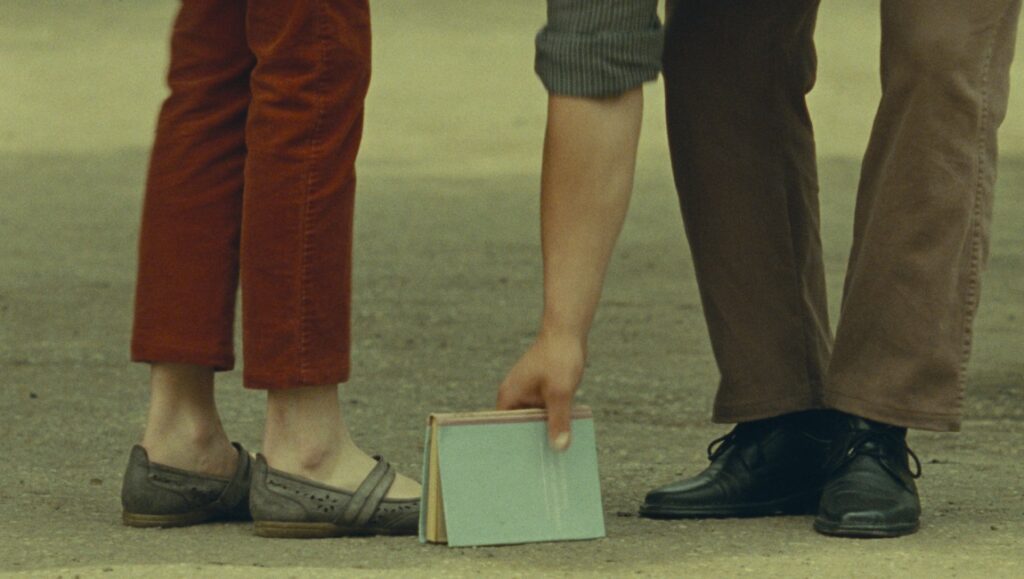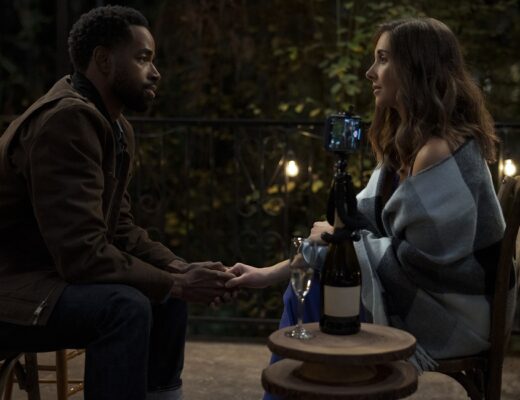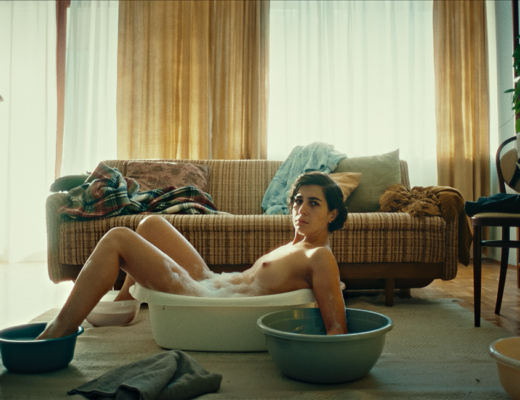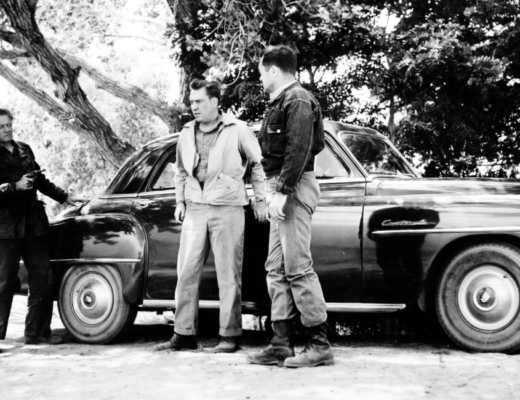Social Hygiene
Retreating from the weight of actions into the weightlessness of words, Denis Côté’s latest finds a rambunctious solace in the oratorial. Serving possibly as a stylistic antithesis to 2019’s dialogue-free Wilcox (centered around the life of a drifter), the opportunely-titled Social Hygiene recalls, instead, a linguistic primacy favored by and featured in the films of Jean-Marie Straub and Danièle Huillet. Like them, Côté engages in the dialectical interplay of ideas and ideologies; his structural rigor, evident in the film’s meticulously composed landscapes and thespian dialogue, prefigures his tacitly political focus. But where Straub-Huillet draw their greatest political lessons from history, the Canadian auteur situates his philosophical inquiry within contemporaneous socio-political concerns. Specifically, Social Hygiene bemoans the healthy order of society — but what is hygiene, if not order persevering? — and posits, as its disinfectant, individual apathy.
Côté’s protagonist is Antonin, one such passive candidate; a loafer and thief who takes pride in both, and subsequently excuses his idle and dishonest practices by way of rhetorical chiasmus. A “deep moral fatigue before the ugliness of this world” explains his reluctance to engage with it, whereas pickpocketing, despite its moral failings, demands belief “in a job well done.” His sister, wife, mistress, tax collector, and one of his petty victims seem to disagree. Pronouncing him a dandy whose character remains, despite its superficial freedoms, futilely “tiresome, lacking in originality” among other affronts, the women in Antonin’s life figure larger and more accomplished than him. Over three days, they chide his incurable cynicism and urge him, for the sake of personal respectability, to turn his life around: quit robbing, go to the beach, pursue the arts, pay his taxes, and make amends for a shattered windscreen and stolen goods. Antonin, in turn, stands unabashed amid their ranks, audited on all fronts but refusing to be held accountable.
Conceived a good five years prior to the COVID-19 pandemic on a holiday imbibed with the influences of Modernist writing, Social Hygiene nonetheless encapsulates a greater ennui of post-Modernist times; one tailored to isolation, propped up by linguistic sparrings between its disenfranchised male and his fairer counterparts. Shot in the Québécois woods using mostly static panoramas, Côté’s eccentric comedy assumes a theatricality popular of late with such filmmakers as Eugène Green and Albert Serra; and, following the latter’s Liberté in its Enlightenment-set milieu, furnishes the cast with anachronistic costumes and gestures as befitted their European forebears. A distancing occurs, not only through its Brechtian artifice, but also literally: standing meters apart, and voicing their mutual discontent into the wind, Antonin’s society heralds our zombified own, neutered by political anathema and existential anxiety. Social Hygiene refrains from condemning either interpretation of what constitutes as hygienic; perhaps, especially under lockdown, neither bourgeois optimism nor proletarian fatalism alone proves sufficient.
Writer: Morris Yang

Credit: Berlinale
The Luminous View
One of last year’s standouts, Pietro Marcello’s Martin Eden, traced the trajectory of a writer from his idealistic roots towards a solipsistic cynicism at the end of his career. In fellow Italian countryman Fabrizio Ferraro’s narrative feature The Luminous View, we find a similarly tortured soul in the guise of filmmaker Mr. Emmer (Alessandro Carlini), whose obsession with the German poet and philosopher Hölderlin has led him to a breaking point. Unlike Martin Eden however, we join Emmer not at the beginning, but at the bitter end. The first shots of him are in a hospital bed, which squeaks as it elevates his head to a sitting position and back down again; he bobs in and out of shadows quietly muttering under his breath. In deliberate contrast to its title, the film’s vantage is far from luminous. The characters are cloaked in shadows while brighter sections are marred by an intentionally unfocused lens. These obfuscations, layered on the muted color palette of muddied grays, greens, and browns, evoke Emmer’s frail despondency.
After this cold open, the film jumps a few days before the hospital stay, though Emmer remains largely inscrutable all the same. Carlini admirably cloaks his performance in sullen introspection, but the script gives him little to work with beyond curt responses or trailing non-sequiturs. “She must have lost his love in the Lisbon earthquake,” he mutters under breath with eyes transfixed on the distance. Whether the man is merely lost in his obsessions or succumbing to a serious health issue is left ambiguous. Our only way into his world is through the brief interactions with his assistant Catarina (Catarina Wallenstein), but while their dynamic bears a cursory resemblance to the tense Kristen Stewart/Juliette Binoche relationship in Clouds of Sils Maria, there is a total lack of interiority to Catarina’s character, who ends up shyly acquiescing to Emmer at nearly every turn until it’s far too late. The two travel together to do research on Hölderlin for his upcoming film and as far as assistantships go things could hardly be worse. Emmer refuses to drive, refuses to wear a seatbelt, refuses to talk, and even refuses to leave the car at night. The beleaguered Catarina is forced into a motherly role. “Did you bring an extra pair of socks?” she asks as the rain hammers at the windshield. Later in the film Emmer opens the door of the moving car and walks off into a field, Catarina runs behind him with his bag, as he struts forward headstrong like a sulking toddler with a cigarette.
It’s at this point, late into the second half, that the film stalls out altogether, trapped somewhere between Catarina’s preternatural deference and Emmer’s sullen despondence. Ferraro goes all-in on the latter, discarding the assistant outright and deciding to close on an extended sequence that finds Emmer walking down one forest trail after another with nothing but incoherent bits and mutterings to pierce the silence. In the most memorable part of this monologuing, he describes the way the spacing of a spider’s web is constructed specifically to be made invisible to the flies’ eye-view. This neat little metaphor for the prey collapsing into a trap cleanly parallels Emmer’s gradual descent — meant to mirror Hölderlin’s late-life breakdown — but it might as well apply to Ferraro’s indulgent narrative, which so entwines itself in enigmatic distance and obfuscations that barely any clarity, emotion, or light can escape.
Writer: Igor Fishman
For Lucio
The COVID pandemic kept Pietro Marcello’s Martin Eden out of U.S. cinemas (settling for a virtual-only release) in 2020, but the film’s much-hyped 2019 festival run translated into stateside celebration nevertheless, amusingly culminating in an Obama cosign. The film’s appeal is readily apparent, even if some have called into question the strength of its ideological insight — Marcello’s movie, in fact, looks like a movie, an assemblage of 35mm and 16mm footage (some of it repurposed archival) color graded for continuity and to approximate the filmic look of pre-digital cinema. It’s an aesthetic approach honed across a decade’s worth of stylized nonfiction filmmaking (Martin Eden being Marcello’s second narrative feature), and one that characterizes his latest feature, For Lucio.
This new documentary is a more restrained effort than the sprawling Eden or the daring narrative/nonfiction hybrid The Mouth of the Wolf, working out to be fairly standard music biography material with the benefit of Marcello’s cinematic stylings. The subject in question is Lucio Dalla, the multi-talented musician and performer who made music celebrating and commemorating the struggles of working-class Italians in the late ‘60s and onward, most famously collaborating with leftist poet and lyricist Roberto Roversi in the 1970s. Marcello has brought together a beautiful selection of archival interviews and concert footage for this project, often cutting in and out with a rhythm informed by Dallo’s music, drifting into images of the Italian people and locales the late artist sang of. This nimble, seemingly freeform approach to editing together the film’s pre-existing and found material keeps proceedings lively, and balances out the quieter moments spent interviewing Dalla’s long-time friend and manager Tobia. Marcello clearly feels these interviews are imperative to legitimizing his film and weighs them as heavily as his own montage work (and shoots and colors them on 35mm to match), but while Tobia (and eventually Stefano Bonaga, a childhood friend) provide essential first-hand testimony and clear-eyed appraisal of Dalla from the safety of old age, the centering of his interviews keep For Lucio in the realm of the conventional. This isn’t an entirely terrible choice for a film that clearly favors the pre-existing knowledge of its Italian audience members while still seemingly destined for some international play. And while it is a curious choice in project for Marcello right after a brush with significant public visibility, it’s one that, at the very least, indicates a singular, confident vision.
Writer: M.G. Mailloux

Credit: Faraz Fesharaki/DFFB
What Do We See When We Look at the Sky
Alexandre Koberidz’s first feature, Let the Summer Never Come Again, begins with the maxim, “Love has no end — a story always has,” followed by, “You will now see: a lovestory.” This cleft within the romantic drama’s conventionally pleasing, if quaint, narrative and temporal backbone having been marked out, he proceeds to the main attraction: a 202-minute, cellphone-shot city symphony. There, human presence functioned less as a flavoring agent or realist window-dressing than as fleshy extensions to canvases of the surrounding landscape, the former often subsumed into fluctuations in light and exposure. Far from hollowing out his images’ sensual allure, such disturbances only served to highlight the delicacy and ductility of the filmed bodies, their physical properties sublimated and concatenated as a series of energies cycled between, at times mirrored by the environment’s flaring changes. In this spirit, the head-to-head whisperings, coquettish come-ons and general introversion so customary to the first date (or one-night-stand, or summertime fling, take your pick) are flattened into a soupy mix of gestures, utterances, declarations and reflections unimputed to any one pair. His sophomore work, What Do We See When We Look At the Sky, whose increased production values give it a comparatively hyaline quality, faithfully bears forward this adventurous approach.
Spawned from a reality somewhat coterminous with ours — minus the occasional flight of fantasy involving talking drainpipes and soccer-bro canines — a chance meeting between two strangers outside a school gate sets them on a heavens-willed course towards propinquity. That same night, Lisa (Ani Karseladze) and Giorgi (Giorgi Bochorishvili) encounter each other again at a crossing, and an arrangement to certify their shared fortune is casually wafted. Catching the glimpse of an “evil eye,” however — an abstract antiparticle to the in-universe conception of first love, a spellcaster whose scheming purview this couple so unfortunately fall within, maybe even the camera eye itself? — we soon behold a union riven. Each loses their most precious talent — his athletic mojo, her medical expertise. And extending Christian Petzold’s unilateral games of courtship, each finds their face irreversibly altered but certain the other still pines for their heart. True to a protagonist’s stated belief that chance is trustworthy, the separation announces itself without any melodramatic hand-wringing, the lovers’ search ever-deferred amid the circadian rhythms of everyday life that precede and succeed romance itself.
Accordingly, Koberidze’s aperture widens to take in the notes of beauty that insinuate themselves in the fringes. Lisa and Giorgi’s scuppered date gives way to a group of young revelers in the vicinity, their joyful faces periodically articulated by sprinkler lights. Interactions are playfully stilted, and the aforementioned initial coupling is observed from ankle-height, a bizarre exchange of formality repeated and codified thrice over in increasingly clipped fashion. It’s this childlike, but never childish, perspective that confers a considerable specificity onto the most unassuming passages: children waiting patiently for an ice cream cone, reflections dancing across a piano lid, overlapping networks of branches and leaves rendered a living magic-eye puzzle. Koberidze’s free-orbit doesn’t end there, and he is at once intrigued by the unifying force of national sport and by mass indifference to violence enacted across the globe. In previous dialogue, he deals with the recourse to passivity represented by filmmaking as an escape maneuver, a concern that resurfaces during What Do We See’s closing scenes. Comfortingly, if idealistically, the film posits an alternative discursive mechanism, one that rejects the rigorously-apportioned, atomized systems of characterization and narratology prized by most in favor of the collective lifeforce from which they are excerpted. Individual stories, imbricated as they are with the ebb of others’ and subject to the unknowable temperament of a material world, flow together in a mixture just as hard to divine as the sky on an overcast day, and only by keening ourselves to the totality of their offerings can we usher in a kinder, more free-spirited cinema.
Writer: Nicholas Yap
Les Attendants
We are asked: what of the implications of these encounters? What of the markings left by a history: markings that will elude the act of their initial etch? In Truong Minh-Quý’s follow-up to his debut feature The Tree House — a postcolonial science fiction docudrama, utilizing the anonymity of a forest in its reevaluation of an ethnographic gaze — he continues this exploration of what such an expansive greenery might offer, revisiting an inquiry into such spaces and the marks made bare within hidden crevices. Les Attendants concerns itself with two surveys of the ephemeral: a couple, two older white men in the pursuit of cruising, and a younger black man caught in migratory stasis. Transient observations testify of imprints left and barely noticed: engravings of a limb dragged through dirt, the chipped bark of trees, small fractures the size of a fingernail. For a short work, there is a clear understanding that in dealing with such fleeting dynamics, it’s in stilted gestures that a certain poetry can find purchase and create a distancing effect so that we might be able to see not the interiority of what is happening before our eyes, but rather the elusiveness of the exterior, the blankness of these two narrative confrontations that will ultimately persist.
This forest is one echoing with its own past. These two stories, and the happenstance of their momentary entanglement, are but the pangs of reverberation. Here, it seems that Troung’s curious eye is directed toward the suggestion of an inherent benefit: he asks, in the cacophony of history, whose narrative do we come to hear? Whose perspective comes to be considered? These are not questions that should incite much provocation, as such ideas are ones we already find ourselves headily contending with, particularly within this ethos. But in the specific, almost haiku-esque verse with which Troung articulates these notions, there is an idiosyncrasy both intimate and beautiful. Much like his feature, it’s in the aesthetic ruptures of an intentional discontinuity — here, in an estrangement cultivated by A.) a lack of context surrounding the two presented narratives and B.) the film’s conclusion, as a reflexive intervention (a surprise best left vague here) bluntly cuts us off from the telling of a marginal history — where the voice of this emerging artist is most affectionately heard. To sum up this dense, intriguing work with an apt platitude: an exciting work by an exciting young filmmaker.
Writer: Zachary Goldkind







